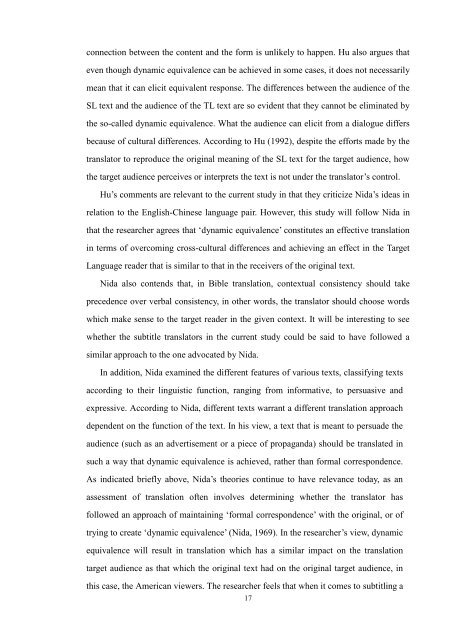View - Scholarly Commons Home
View - Scholarly Commons Home
View - Scholarly Commons Home
You also want an ePaper? Increase the reach of your titles
YUMPU automatically turns print PDFs into web optimized ePapers that Google loves.
connection between the content and the form is unlikely to happen. Hu also argues that<br />
even though dynamic equivalence can be achieved in some cases, it does not necessarily<br />
mean that it can elicit equivalent response. The differences between the audience of the<br />
SL text and the audience of the TL text are so evident that they cannot be eliminated by<br />
the so-called dynamic equivalence. What the audience can elicit from a dialogue differs<br />
because of cultural differences. According to Hu (1992), despite the efforts made by the<br />
translator to reproduce the original meaning of the SL text for the target audience, how<br />
the target audience perceives or interprets the text is not under the translator‟s control.<br />
Hu‟s comments are relevant to the current study in that they criticize Nida‟s ideas in<br />
relation to the English-Chinese language pair. However, this study will follow Nida in<br />
that the researcher agrees that „dynamic equivalence‟ constitutes an effective translation<br />
in terms of overcoming cross-cultural differences and achieving an effect in the Target<br />
Language reader that is similar to that in the receivers of the original text.<br />
Nida also contends that, in Bible translation, contextual consistency should take<br />
precedence over verbal consistency, in other words, the translator should choose words<br />
which make sense to the target reader in the given context. It will be interesting to see<br />
whether the subtitle translators in the current study could be said to have followed a<br />
similar approach to the one advocated by Nida.<br />
In addition, Nida examined the different features of various texts, classifying texts<br />
according to their linguistic function, ranging from informative, to persuasive and<br />
expressive. According to Nida, different texts warrant a different translation approach<br />
dependent on the function of the text. In his view, a text that is meant to persuade the<br />
audience (such as an advertisement or a piece of propaganda) should be translated in<br />
such a way that dynamic equivalence is achieved, rather than formal correspondence.<br />
As indicated briefly above, Nida‟s theories continue to have relevance today, as an<br />
assessment of translation often involves determining whether the translator has<br />
followed an approach of maintaining „formal correspondence‟ with the original, or of<br />
trying to create „dynamic equivalence‟ (Nida, 1969). In the researcher‟s view, dynamic<br />
equivalence will result in translation which has a similar impact on the translation<br />
target audience as that which the original text had on the original target audience, in<br />
this case, the American viewers. The researcher feels that when it comes to subtitling a<br />
17

















